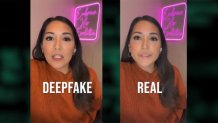When Amanda Aguilar saw a video of what appeared to be her speaking, she was stunned. It looked just like her – but it wasn’t. The video was a deepfake.
Aguilar learned a scammer took a real video she posted to Instagram and then used artificial intelligence to create a fake video in hopes of catfishing someone. Compared side by side Only on 4, the videos are eerily similar.
“For someone to go out of their way and make a deepfake of me is just like, what? I knew deep fakes were a thing, I just never thought I'd be a victim of one,” said Aguilar, who went to graduate school in D.C., interned at News4 and went on to work in TV news in California.
Aguilar’s friends told her a few weeks ago someone had made a Facebook page posing as her, using her real Instagram photos. The scammer messaged a viewer named John Pulido.
We've got the news you need to know to start your day. Sign up for the First & 4Most morning newsletter — delivered to your inbox daily. Sign up here.

For several weeks, Pulido thought he was talking to the real Aguilar. He said he got suspicious when the person asked how much money he made. He asked for video proof it was really her and got deepfake videos in response.
“I was like, ‘Oh my God. This is her,’” Pulido said. “It was pretty scary because of how good it was. It was so convincing.”
Local
Washington, D.C., Maryland and Virginia local news, events and information
Pulido said he messaged a friend who knew Aguilar and then learned it was all a scam.
“Just be careful if it just sounds too good to be true, to be talking to a celebrity that reaches out to you,” he said.
Aguilar described the experience as unnerving.
“Someone can take my video and put it out in the public and, you know, say something that maybe I didn't say or do something that I didn't do, and that is scary,” she said.

Digital security pros are seeing a surge in deepfake attacks
The number of deepfake attacks has been up, said Vijay Balasubramaniyan, the CEO of a digital security company called Pindrop.
“We're seeing a 1,400% explosion in the amount of deepfake attacks,” he told News4.
His company developed a software that can instantly detect deepfakes by looking for mistakes in the file.
“Like for example, when you say, ‘Hello, Paul,’ your mouth is wide open when you say ‘hello’ and it shuts down when it says ‘Paul,’” he explained. There's a certain speed with which you can do that because you're human. Machines don't care about these speeds”
The CEO said there’s not much people can do to prevent their public online content from being stolen.
“The onus is on the platforms to start providing abilities to detect when something is generated by Amanda and when it is AI generated without her consent,” he said.
Aguilar said she now will be “a little more picky” about what she shares online.
An expert’s tips on how to detect a deepfake
The AI expert said if you ever need to verify if someone is who they say they are, ask them to hop on a live video call, like a Zoom or FaceTime call. Don’t settle for a pre-taped video, because those are easier for scammers to fake, he said. That said, live video calls also can be faked.
Be on the lookout for strange pauses as someone speaks, because that could indicate a machine is trying to program the video in real time, Balasubramaniyan said.
Another tactic is to ask the person to wave their hand in front of their face. That adds a layer of complexity that’s harder for AI generators to keep up with, so the hand will usually look strange – sometimes with additional fingers.
News4 sends breaking news stories by email. Go here to sign up to get breaking news alerts in your inbox.



